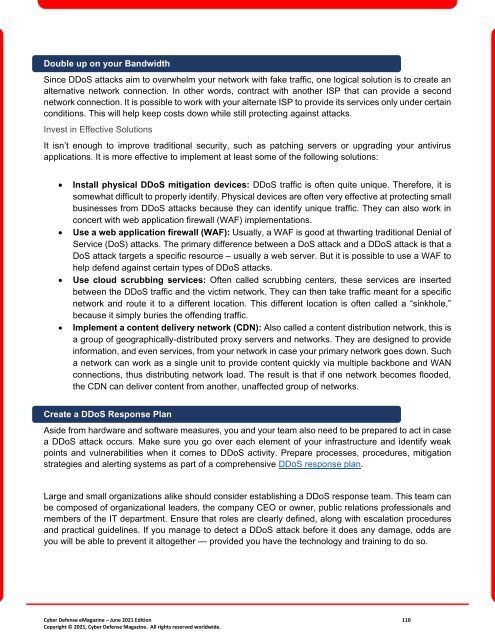Cyber Defense eMagazine June 2021 Edition
Cyber Defense eMagazine June Edition for 2021 #CDM #CYBERDEFENSEMAG @CyberDefenseMag by @Miliefsky a world-renowned cyber security expert and the Publisher of Cyber Defense Magazine as part of the Cyber Defense Media Group as well as Yan Ross, US Editor-in-Chief, Pieruligi Paganini, Co-founder & International Editor-in-Chief, Stevin Miliefsky, President and many more writers, partners and supporters who make this an awesome publication! Thank you all and to our readers! OSINT ROCKS! #CDM #CDMG #OSINT #CYBERSECURITY #INFOSEC #BEST #PRACTICES #TIPS #TECHNIQUES
Cyber Defense eMagazine June Edition for 2021 #CDM #CYBERDEFENSEMAG @CyberDefenseMag by @Miliefsky a world-renowned cyber security expert and the Publisher of Cyber Defense Magazine as part of the Cyber Defense Media Group as well as Yan Ross, US Editor-in-Chief, Pieruligi Paganini, Co-founder & International Editor-in-Chief, Stevin Miliefsky, President and many more writers, partners and supporters who make this an awesome publication! Thank you all and to our readers! OSINT ROCKS! #CDM #CDMG #OSINT #CYBERSECURITY #INFOSEC #BEST #PRACTICES #TIPS #TECHNIQUES
Create successful ePaper yourself
Turn your PDF publications into a flip-book with our unique Google optimized e-Paper software.
Double up on your Bandwidth<br />
Since DDoS attacks aim to overwhelm your network with fake traffic, one logical solution is to create an<br />
alternative network connection. In other words, contract with another ISP that can provide a second<br />
network connection. It is possible to work with your alternate ISP to provide its services only under certain<br />
conditions. This will help keep costs down while still protecting against attacks.<br />
Invest in Effective Solutions<br />
It isn’t enough to improve traditional security, such as patching servers or upgrading your antivirus<br />
applications. It is more effective to implement at least some of the following solutions:<br />
• Install physical DDoS mitigation devices: DDoS traffic is often quite unique. Therefore, it is<br />
somewhat difficult to properly identify. Physical devices are often very effective at protecting small<br />
businesses from DDoS attacks because they can identify unique traffic. They can also work in<br />
concert with web application firewall (WAF) implementations.<br />
• Use a web application firewall (WAF): Usually, a WAF is good at thwarting traditional Denial of<br />
Service (DoS) attacks. The primary difference between a DoS attack and a DDoS attack is that a<br />
DoS attack targets a specific resource – usually a web server. But it is possible to use a WAF to<br />
help defend against certain types of DDoS attacks.<br />
• Use cloud scrubbing services: Often called scrubbing centers, these services are inserted<br />
between the DDoS traffic and the victim network. They can then take traffic meant for a specific<br />
network and route it to a different location. This different location is often called a “sinkhole,”<br />
because it simply buries the offending traffic.<br />
• Implement a content delivery network (CDN): Also called a content distribution network, this is<br />
a group of geographically-distributed proxy servers and networks. They are designed to provide<br />
information, and even services, from your network in case your primary network goes down. Such<br />
a network can work as a single unit to provide content quickly via multiple backbone and WAN<br />
connections, thus distributing network load. The result is that if one network becomes flooded,<br />
the CDN can deliver content from another, unaffected group of networks.<br />
Create a DDoS Response Plan<br />
Aside from hardware and software measures, you and your team also need to be prepared to act in case<br />
a DDoS attack occurs. Make sure you go over each element of your infrastructure and identify weak<br />
points and vulnerabilities when it comes to DDoS activity. Prepare processes, procedures, mitigation<br />
strategies and alerting systems as part of a comprehensive DDoS response plan.<br />
Large and small organizations alike should consider establishing a DDoS response team. This team can<br />
be composed of organizational leaders, the company CEO or owner, public relations professionals and<br />
members of the IT department. Ensure that roles are clearly defined, along with escalation procedures<br />
and practical guidelines. If you manage to detect a DDoS attack before it does any damage, odds are<br />
you will be able to prevent it altogether — provided you have the technology and training to do so.<br />
<strong>Cyber</strong> <strong>Defense</strong> <strong>eMagazine</strong> – <strong>June</strong> <strong>2021</strong> <strong>Edition</strong> 110<br />
Copyright © <strong>2021</strong>, <strong>Cyber</strong> <strong>Defense</strong> Magazine. All rights reserved worldwide.


















